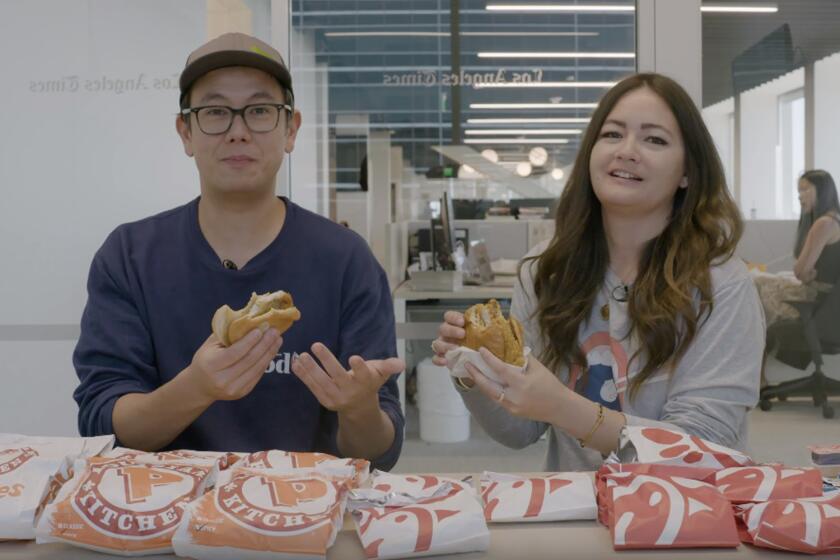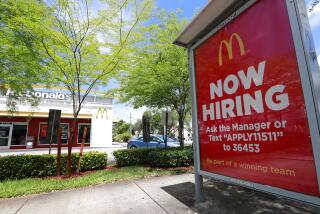Commentary: Popeyes chicken sandwich is an economic indicator
- Share via
Strong economies and tight labor markets put strains on fast-food companies. How can they remain profitable when wages are rising? The social media frenzy over the new chicken sandwich at Popeyes shows the success of one classic play: Introduce an iconic new menu item, and charge more for it.
At $3.99, the item is asking a bit more from customers than Chick-fil-A’s competing sandwich — but apparently it’s not asking too much. It has been so popular that restaurants are selling out. The New Yorker magazine declared Tuesday: “The Popeyes Chicken Sandwich Is Here to Save America.” If there’s a new chicken sandwich king, we can thank the strong consumer economy.
The fast-food industry is very responsive to consumer tastes and budgets because it’s so huge and price-competitive. When times are bad, and their customers are on tight budgets, value menus and promotions might be the order of the day. When times are good, it’s a different matter.
Consumers are still choosing fast food because they’re looking for a deal, but as companies struggle with rising food and labor costs, their margins are getting squeezed. Raising prices on existing menu items can help maintain profit margins, but go too far and consumers might revolt. A different kind of “inflation” is introducing new products, at higher prices, to woo existing or new customers.
Popeyes takes on Chick-fil-A with its new chicken sandwich. Which one is better?
Perhaps it’s no surprise that the two iconic burgers in the fast-food industry — Burger King’s Whopper and the McDonald’s Big Mac — were both introduced during times of low unemployment like we have today. The Whopper launched in 1957, a year when the unemployment rate dropped as low as 3.7%. Burger King’s co-founder noticed that a rival establishment was seeing good sales of a bigger burger, and he sought to imitate it.
The Big Mac owes its success to a particularly entrepreneurial McDonald’s franchisee. Jim Delligatti hatched the idea in his Pittsburgh restaurant as a way of increasing sales. In 1967, with the national unemployment rate also below 4%, what was to become known as the Big Mac was born. It went national a year later.
It’s a somewhat similar story for the Six Dollar Burger from Carl’s Jr. and Hardee’s. In the late 1990s Carl’s Jr. was a stagnant franchise getting squeezed by McDonald’s and Burger King at the low end as well as by higher-priced fast-casual concepts. The Six Dollar Burger — priced at $3.95 — was a way of offering a premium product that still offered fast-food speed and value. It rolled out in August 2001, which turned out to be the last month when Americans still thought the late-1990s boom might continue.
The fast-food industry also suffered some blowback from its profit-inflating strategies in the late 1990s. In 1993, McDonald’s promoted a “Dino-sized” value meal in response to the opening of the movie “Jurassic Park.” It became such a hit that super-sizing was born. That led to a super-sizing arms race throughout the industry for the rest of the decade, leading to surging fast-food profits in the late 1990s — coinciding with a growing obesity crisis. After public outcry in response to the documentary “Super Size Me,” McDonald’s phased out super-sized portions in 2004.
These two dynamics — the fast-food industry’s need to find a new source of profits in a good economy with growing cost pressures, and the industry’s reputation as a bad actor in the obesity crisis — provide the backdrop for the product launches that the industry has produced this year. Before the Popeyes sandwich came chains’ splashy announcements about menu items featuring Beyond Meat or Impossible products. In addition to not being real meat and hence having the veneer of health-consciousness, Beyond Meat and Impossible items aren’t cheap.
The Popeyes chicken sandwich isn’t trying to be bigger or cheaper; the hook is really about trying to be a better chicken sandwich than Chick-fil-A’s by featuring a brioche bun, a full layer of pickles and either a spicy Cajun spread or mayonnaise. While the nearest Chick-fil-A to me sells its chicken sandwich for $3.49, the Popeyes one is 14% higher at $3.99.
The economy’s good times can’t go on forever, but some booms give us a gift that lasts: the Whopper, the Big Mac, the Six Dollar Burger — and now, perhaps, the Impossible Burger and the Popeyes chicken sandwich.
More to Read
Inside the business of entertainment
The Wide Shot brings you news, analysis and insights on everything from streaming wars to production — and what it all means for the future.
You may occasionally receive promotional content from the Los Angeles Times.











